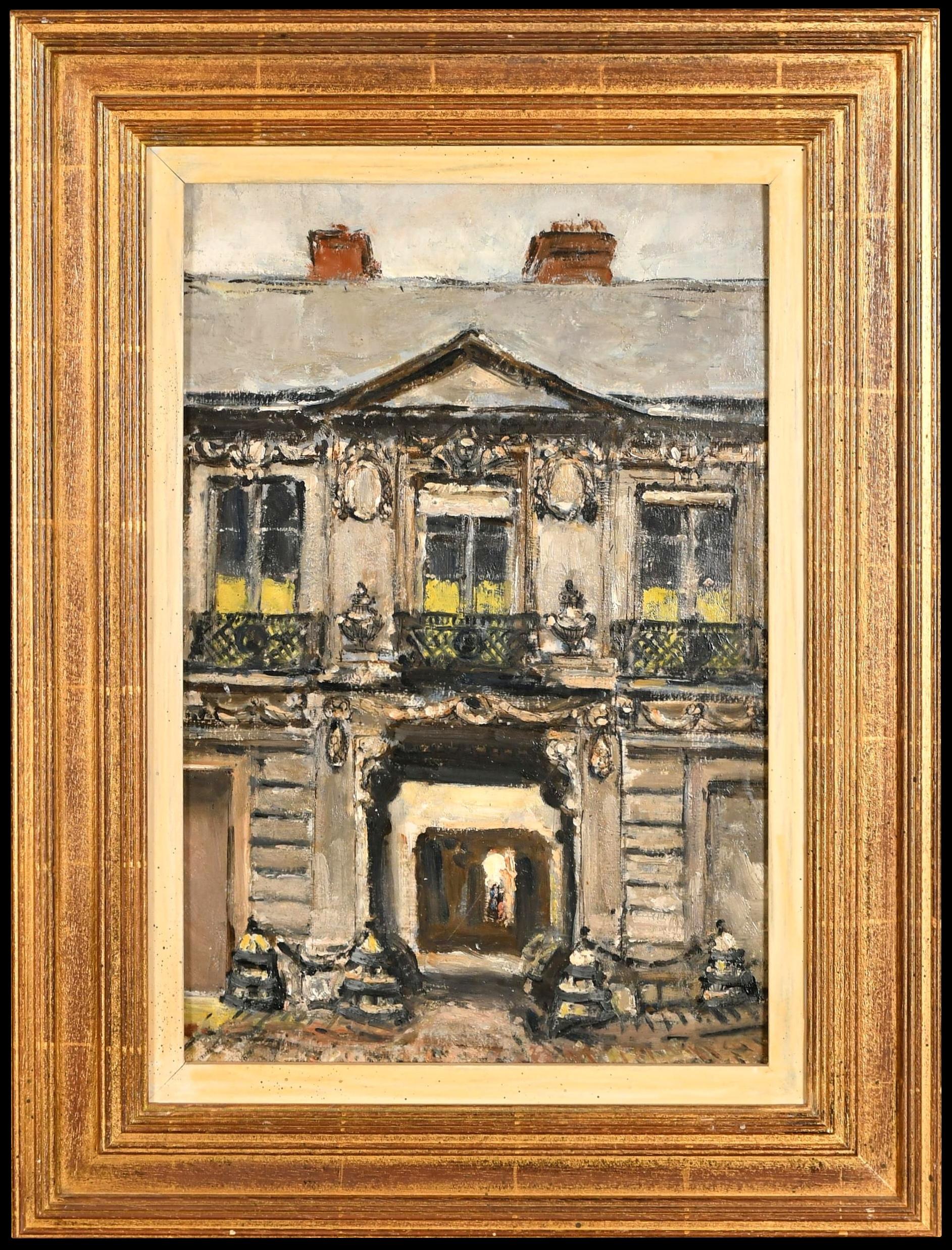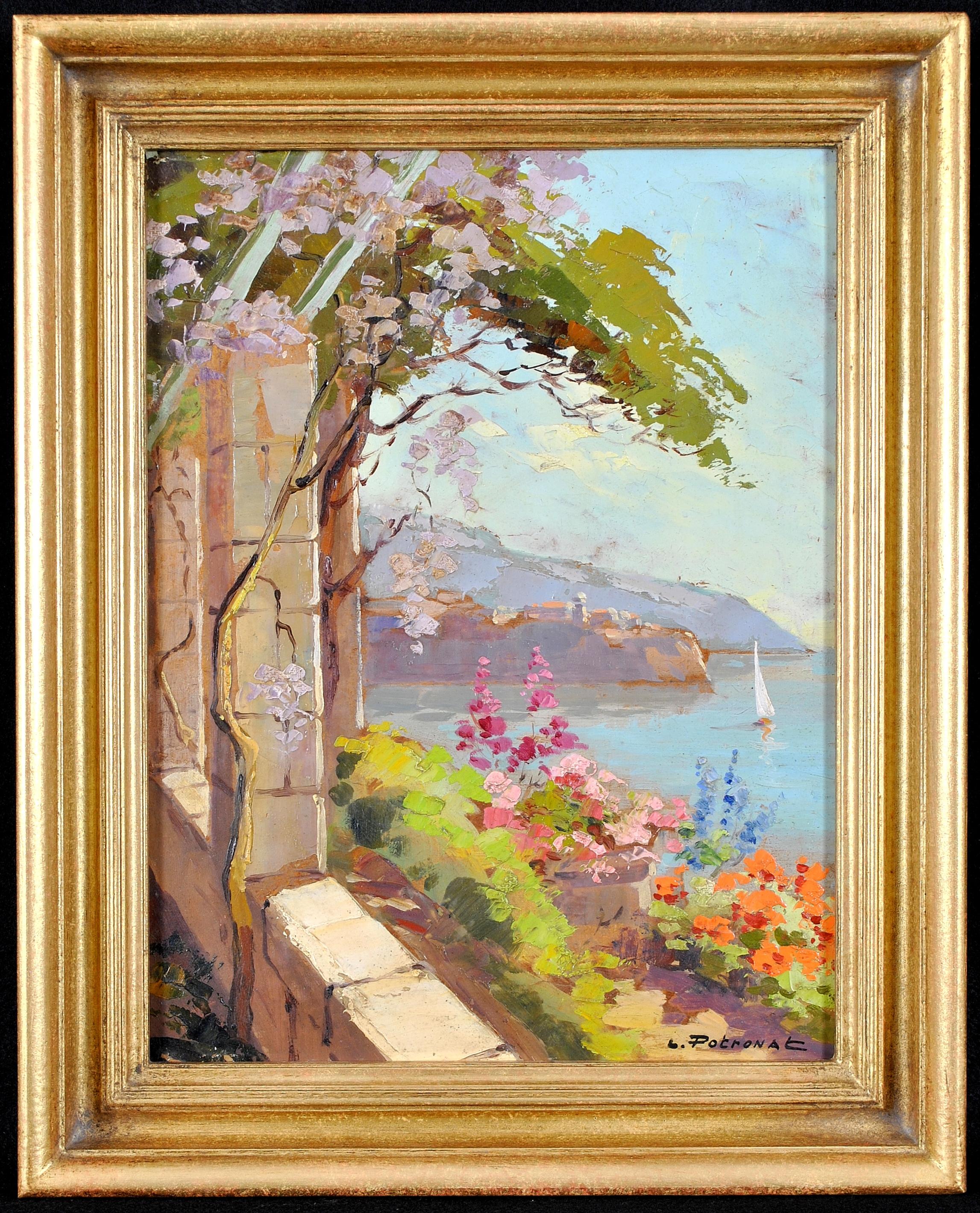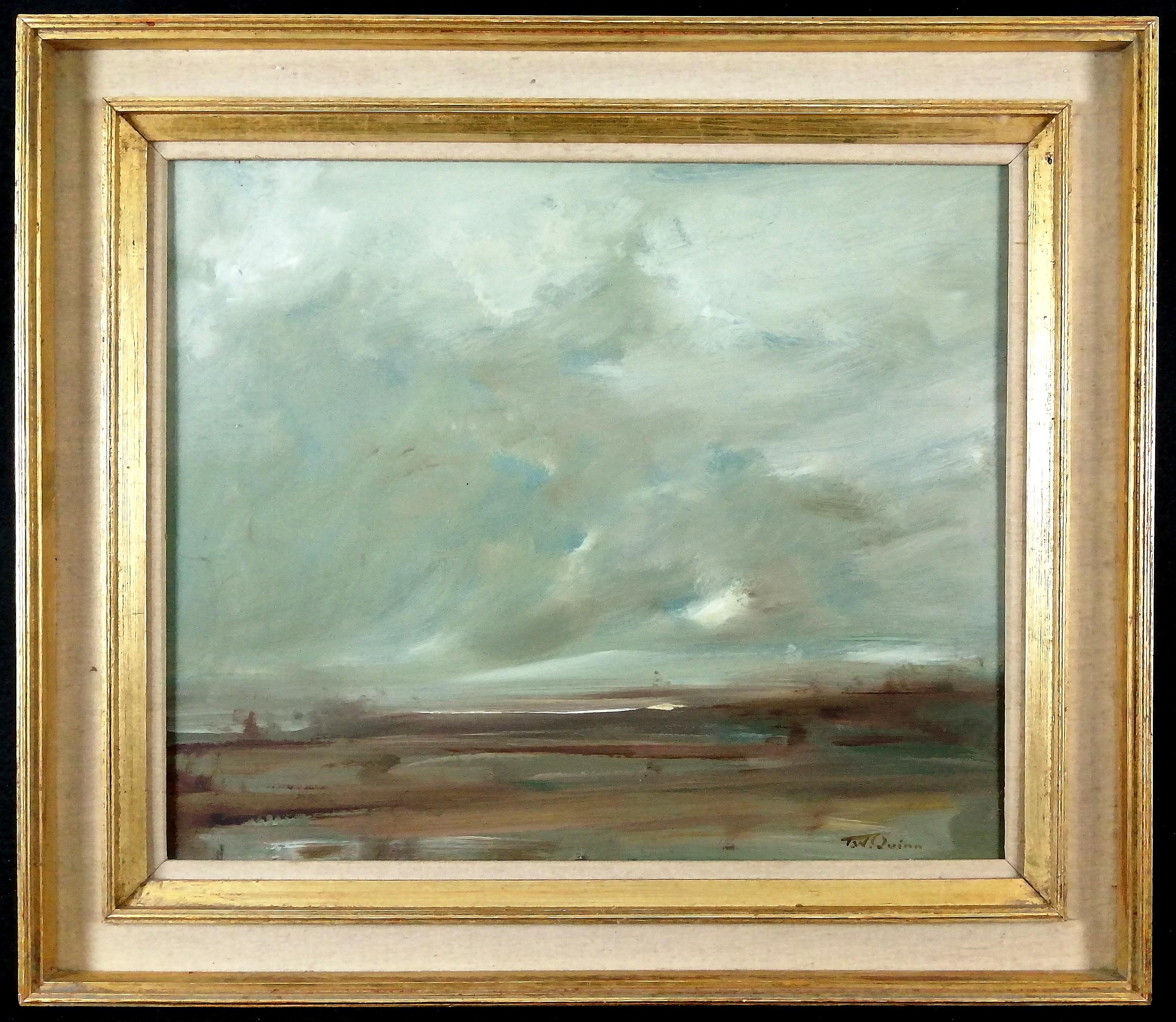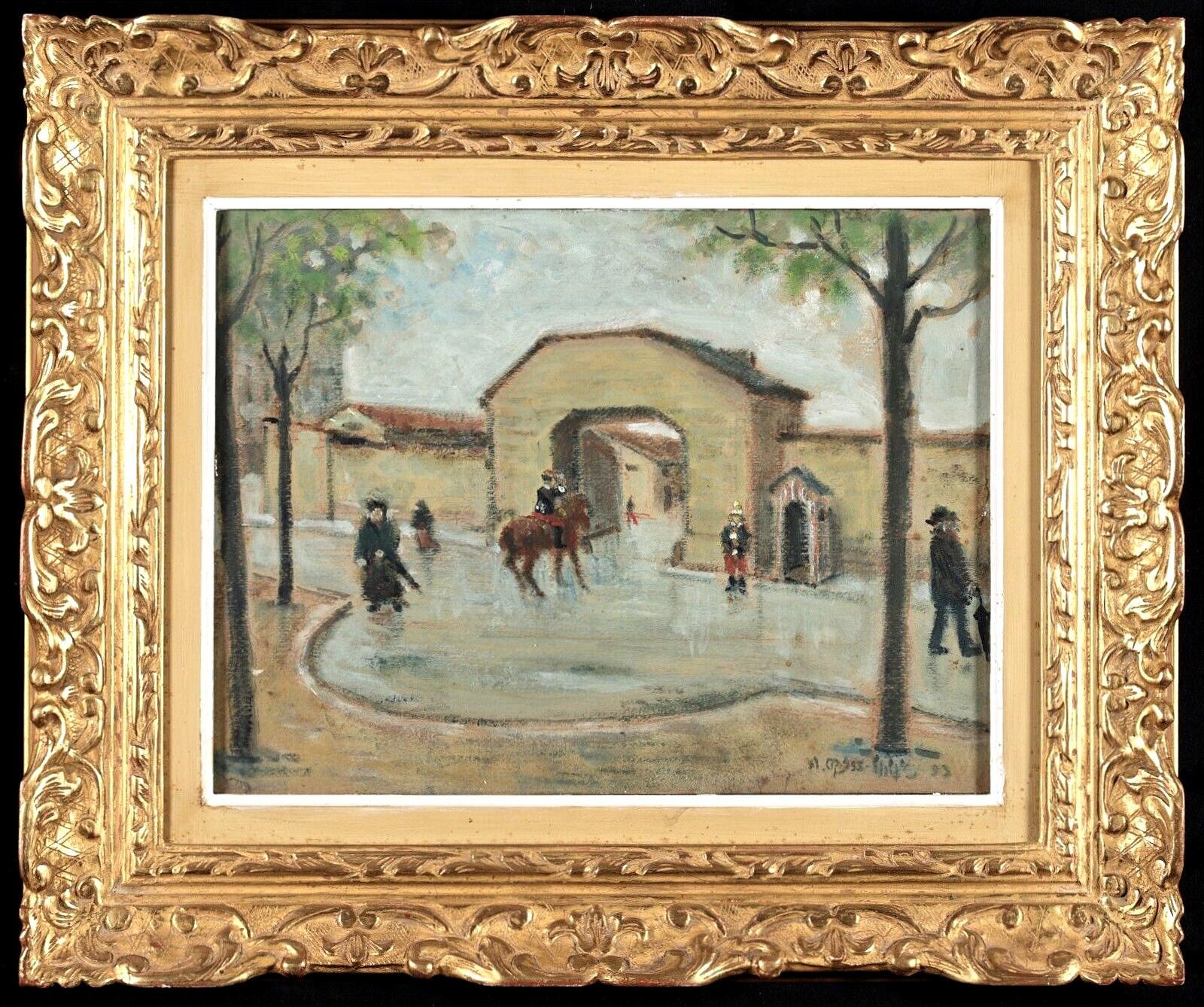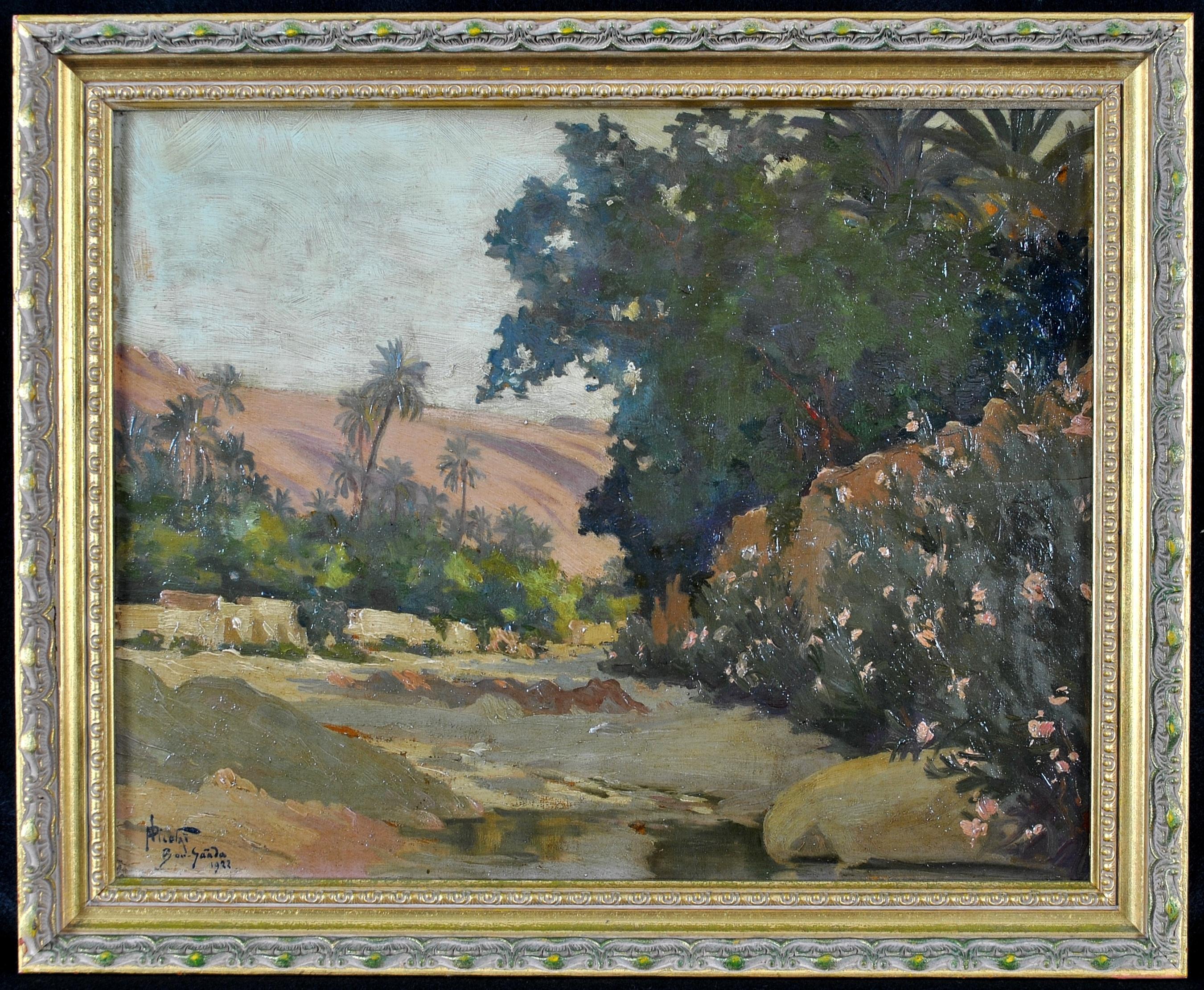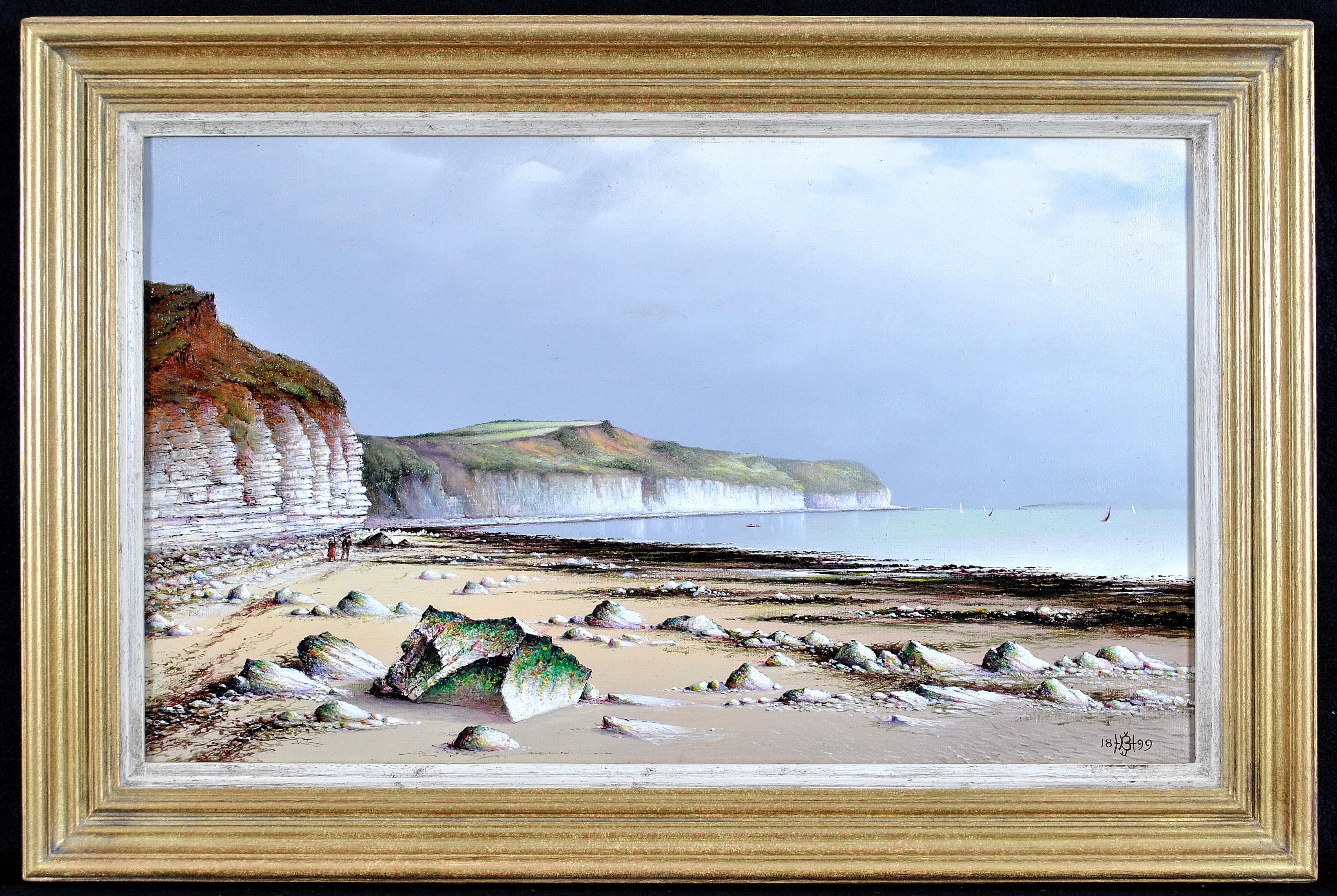Paul SchumannPair Early New Mexico Landscapes with Structures Heavy Impasto Galveston ArtistCirca 1920s
Circa 1920s
About the Item
- Creator:Paul Schumann (1876 - 1946)
- Creation Year:Circa 1920s
- Dimensions:Height: 14 in (35.56 cm)Width: 18 in (45.72 cm)Depth: 6 in (15.24 cm)
- Medium:
- Movement & Style:
- Period:
- Condition:
- Gallery Location:San Antonio, TX
- Reference Number:1stDibs: LU76934980332
Paul Schumann
Paul R. Schumann was a Texas impressionist seascape painter, who has been called the Gulf Coast counterpart of Winslow Homer. He was born in Reichersdorf, in the German State of Saxony, in 1876, one of four children of Albert F. Schumann and Mina Clara Zincke. Only he and his brother, Albert Otto, survived infancy. The family emigrated to the United States, in 1879 and settled in Galveston, Texas, where he lived until his death. Schumann evinced an early interest in art and received encouragement from the superintendent of the Galveston Public Schools. He studied painting with local painter, Julius Stockfleth, before turning to plein air painting. He married Carolina Adela Bergmann from Fredericksburg, Texas, in 1903 and later credited her as his inspiration. They had three children, Paul August, Clara Adela and Robert Edward. Carolina died in 1937. He painted many paintings in and around Fredericksburg, as well as New Mexico. Schumann started out as a portrait and landscape painter, but became best known for his later seascapes and harbor scenes. Writers have speculated that his preference for marine subjects was influenced by a childhood experience of falling into the mill race, at his father's sawmill or by his cross-ocean journey, at the age of three. One critic wrote that he catches with unfailing dexterity, the kinship of the sea with the sky and the land,the storm clouds, the pouty, sulky thunderheads or the washed sky, after an April shower.
Schumann built model ships, for use as models for his seascapes, which sometimes featured boats and ships, ranging from fishing vessels to three-masted schooners. During the 1910s, he traveled extensively around the United States, painting in New Mexico, Arizona, Colorado, California, Illinois and along the southeastern Atlantic Coast. His favorite site remained the Texas Gulf Coast, for its tropical colors and changeable skyscapes and he became known as a leading interpreter of typical Texas skies, as well as the deeper blues of the South Atlantic and the quiet waters of the Pacific Coast.
Schumann belonged to a number of art associations, including the Art Association of New Orleans, Galveston Art League, Society of Independent Artists, Society of Texas Artists, Southern States Art League and Texas Fine Arts Association. Schumann exhibited his work frequently and over the course of his career, won many exhibition awards, prizes and medals. His work is held in the collections of a number of museums and institutions, including the Rosenberg Library (Galveston, Texas), Fort Worth Art Museum (Texas), the Panhandle-Plains Historical Museum (Texas) and Southwest Texas State University. He died of pancreatic cancer, in 1946.
Schumann began as a realist and evolved into an impressionist, likewise, moving from brush to palette knife as his primary tool. Of his painting, The Storm, he noted that he began with a brush and later used his fingers. His heavy impasto has been likened to that of Wayne Thiebaud. His palette relied heavily on the primary colors and he worked mainly in oils, but also made watercolor, pen-and-ink and crayola studies. He frequently worked outdoors, becoming a familiar figure to local fishermen, who would sometimes shift their boats around to help out his compositions. In part, because of an impressionist technique that did not allow for a great deal of overpainting, Schumann was a prolific artist, who could turn out up to three canvases a day. He is credited with some 1500 paintings, in 25 years and was able to support his family by his painting and private teaching, even during the Depression years.
As a teacher, Schumann was said to require his students to make drawings for five years, before he would allow them to work with color. Critics have praised Schumann for the atmospheric intensity and vigor of his seascapes. One critic wrote that in American art, Mr. Schumann probably has no peer at capturing in oil dancing waters or a sailing ship on a glassy sea. The San Antonio Express admired his clearness of colors, the warm tones of the afternoon reflected sunlight and lovely transparency in the wet beach sand, all aglow from the reflections of the June skies and their billowy sunlit clouds. A French critic termed his work bold, direct and free and called Schumann himself a poet of exquisite sensibility. An American critic concluded that Schumann was doing for the Texas Gulf shores what Winslow Homer did for the Coast of Maine, arguing that if he had been painting along the New England Coast instead of the Gulf of Mexico, his marines would have been known all over the world.
- ShippingRetrieving quote...Ships From: San Antonio, TX
- Return PolicyThis item cannot be returned.
- "BLUEBONNETS IN BLOOM" TEXAS HILL COUNTRY FRAMED 22 X 26 BORN 1949 HEAVY IMPASTOBy Robert HarrisonLocated in San Antonio, TXRobert Harrison (Born 1949) San Antonio Artist Image Size: 16 x 20 Frame Size: 21.5 x 25.5 Medium: Oil on Canvas "Bluebonnets in Bloom" Biography Robert Harrison (Born 1949) Robert H...Category
Early 2000s Impressionist Landscape Paintings
MaterialsOil
- "A TEXAS TRAIL" TEXAS HILL COUNTRY FRAME 30 x 36 BLOOMING PRICKLY PEAR BORN 1949By Robert HarrisonLocated in San Antonio, TXRobert Harrison (Born 1949) San Antonio Artist Image Size: 24 x 30 Frame Size: 30 x 36 Medium: Oil on Canvas Dated 2010 "A Texas Trail" Hill Country Blooming Prickly Pear Cactus Biog...Category
20th Century Impressionist Landscape Paintings
MaterialsOil
- "OCTOBER SNOWS" G. HARVEY WESTERN GERALD JONES SNOW SCENE 22 X 19 FRAMEDBy G. HarveyLocated in San Antonio, TXG. Harvey (Gerald Harvey Jones) (1933-2017) San Antonio, Austin, and Fredericksburg Artist Image Size: 12 x 9 Frame Size: 22 x 19 Medium: Oil "October Snows" G. Harvey, known for paintings closely linked in mood and subject matter to Edouard Cortes [1882-1962], G Harvey creates romanticized street scenes of turn of the century towns in America. Rain slick streets reflect urban lights, and the weather is obviously cold. He grew up in the rugged hills north of San Antonio, Texas from where herds of longhorn cattle were once driven up dusty trails to the Kansas railheads. His grandfather was a trail boss at 18 and helped create an American legend for his grandson. So, the American West is not only the artist's inspiration but his birthright. Harvey's early interest in sketching and drawing slowly evolved into a passion for painting in oils. After graduating cum laude from North Texas State University, Harvey took a position with the University of Texas in Austin, but he soon realized that weekends and nights at the easel did not satisfy his love of painting. He abandoned the security of a full-time job in 1963 and threw his total energy into a fine art career. Harvey paints the spirit of America from its western hills and prairies to the commerce of its great cities. His original paintings and bronze sculptures are in the collections of major corporations, prestigious museums, the United States government, American presidents, governors, foreign leader and captains of industry. The Smithsonian Institution chose Harvey to paint The Smithsonian Dream, commemorating its 150th Anniversary. The Christmas Pageant of Peace commissioned Harvey to create a painting celebrating this national event. He has been the recipient of innumerable awards and the subject of three books. Today, G. Harvey lives in Fredericksburg, Texas, with his wife Pat in a 150-year-old stone home built by German settlers. His studio and residence are nestled within the Historic District of Fredericksburg. It is obligation of fine artists to present us with more than pretty pictures. They must also make us feel. Among the western painters of today, there is none more capable of accomplishing this than G. Harvey. In his paintings, the viewer into only sees the physical elements of his subject, but also senses the mood that surrounds them. It is a remarkable aspect of fine art, which few artists are able to master. Gerald Harvey Jones was born in San Antonio, Texas, in 1933. His grandfather was a cowboy during the trail-driving era when legends grew up along the dusty trails north from Texas. Family stories of wild cattle and tough men were absorbed by a wide-eyed boy and became the genesis of G. Harvey's art. A graduate in fine arts at North Texas State University, Harvey taught full-time and painted nights and weekends for several years. It was through painting that he found his greatest satisfaction, and his native central Texas hill country provided the inspiration for most of his earliest work. With the development of his talent and the growth of his following, Harvey began to expand his artistic horizons. He left teaching and concentrated on a career in fine art. He sought the essence that is Texas and found it not only along the banks of the Guadalupe, but in cow camps west of the Pecos, and in the shadows of tall buildings in big Texas cities. The streets of Dallas once echoed with the sound of horse's hooves and the jingle of spurs. Historic photographs reveal what it looked like, but only an artist like Harvey can enable a viewer to experience the mood and flavor or the time. Contemporary west art has too often centered on the literal representations from its roots in illustrations. Artists like G. Harvey take us a step further, to the subjective impressions that are unique to each great talent, and which constitutes something special and basic to fine art expression. Harvey is a soft-spoken and unassuming man who cares deeply about what he paints without becoming maudlin or melodramatic. We sense there is more in each Harvey painting than just that which is confined to the canvas. Resources include: The American West: Legendary Artists of the Frontier, Dr. Rick Stewart, Hawthorne Publishing Company, 1986 Artist G. Harvey grew up in the rugged hills north of San Antonio, Texas from where herds of longhorn cattle were once driven up dusty trails to the Kansas railheads. His grandfather was a trail boss at 18 and helped create an American legend. So, the American West is not only the artist's inspiration but his birthright. Harvey's early interest in sketching and drawing slowly evolved into a passion for painting in oils. After graduation cum laude from North Texas State University, Harvey took a position with the University of Texas in Austin, but he soon realized that weekends and nights at the easel did not satisfy his love of painting. He abandoned the security of a full-time job in 1963 and threw his total energy into a fine art career. Two years as a struggling artist followed, but 1965 brought acclaim for the artist's first prestigious show, The Grand National exhibition in New York, and the American Artists' Professional League presented him with their New Master's Award. President Lyndon Johnson discovered his fellow Texan's talent, became a Harvey collector and introduced John Connally to the artist's work. Connally was enthusiastic about Harvey's art, and, on one occasion, he presented a G. Harvey original to each governor of Mexico's four northern states. Harvey paints the spirit of America from its western hills and prairies to the commerce of its great cities. His original paintings and bronze sculptures are in the collections of major corporations, prestigious museums, the United States government, American presidents, governors, foreign leader and captains of industry. The Smithsonian Institution chose Harvey to paint The Smithsonian Dream commemorating its 150th Anniversary. The Christmas Pageant of Peace commissioned Harvey to create a painting celebrating this national event. He has been the recipient of innumerable awards and the subject of three books. Through his art, our history lives. Today, G. Harvey lives in Fredericksburg, Texas, with his wife Pat in a 150-year-old stone home built by German settlers. His studio and residence are nestled within the Historic District of Fredericksburg. Gerald Harvey Jones, better known as G. Harvey, grew up in the Texas Hill Country listening to his father and grandfather tell stories about ranch life, frontier days in Texas, and driving cattle across the Red River. Early in his career, he began to draw inspiration from that collective memory for paintings that would eventually earn him the reputation as one of America's most recognized and successful artists. His art is rooted in the scenic beauty of the land he grew up in and the staunch independence of the people who live there. He says, "My paintings have never been literal representations. They are part first-hand experience, and part dreams generated by those early stories I heard. They are a product of every place I have been, everything I have ever seen and heard." G. Harvey graduated from North Texas State University. He taught in Austin, but continued to study art in his spare time, eventually devoting full time to his painting. The year 1965 was a turning point when he won the prestigious New Masters Award in the American Artist Professional League Grand National Exhibition in New York. It is often said that in viewing a work of art, one is granted a unique look into the thoughts and expressions of values that give meaning to the artist work. Nowhere does this ring truer than the art of G. Harvey. Though Harvey has had nearly two decades of sell-out shows, an outstanding honor came with a series of one-man shows in Washington, D.C. in 1991. The first was at the National Archives featuring his paintings of the Civil War era, then a selection of paintings of notable Washington landmarks was exhibited at the Treasury Department, culminating in a one-man show of 35 paintings at the Smithsonian Institution during their exhibition of The All-American Horse. His work was featured in Gilcrease Museum exhibitions from 1992-1997. In 1987 his alma matter...Category
Late 20th Century Impressionist Landscape Paintings
MaterialsOil
- "Down By The Rio Grande" Texas Cowboy Western SceneLocated in San Antonio, TXFred Darge (1900-1978) Dallas Image Size: 24 x 30 Frame Size: 32 x 38 Medium: Oil, "Down By The Rio Grande" Biography Fred Darge (1900-1978) Friedrich Ernst Darge Born: March 1 1900 Rendsburg, Germany Died: April 10 1978 Dallas, Texas Entered the U.S. ; Jan. 14 1923 at Port Arthur, Texas. By 1924 he was in Chicago painting under the W.P.A. Artists policy and attending the Art Institute of Chicago from where he graduated. While in Chicago he painted and made model sail boats...Category
1940s Impressionist Landscape Paintings
MaterialsOil
- "VESPERS" TEXAS HILL COUNTRY FORESTLocated in San Antonio, TXBarbara Mauldin Fredericksburg Artist Image Size: 12 x 16 Frame: 16 x 20 Medium: Oil "Vespers" Barbara and her husband Chuck moved to Fredericksburg in 2005 after living many years in Louisiana, where she taught art at Baton Rouge Lutheran School. Soon after moving home to Texas, she began painting seriously. She has studied with Ian Roberts, Kevin Macpherson, Jill Carver, Lori Putnam, and (of course!) Chuck Mauldin. Barbara’s work has been accepted in several art events, such as the Women Artists of the West National Show, Contemporary Masters Invitational Art Show in Fredericksburg, the Mountain Oyster Club Art Show, the Plein Air Artists Colorado National Juried Art Exhibition, The Museum of Western Art (Kerrville, TX) “The Party” Art Exhibition and Sale, and others. Her paintings are characterized by color. “I like to emphasize the color that I see, as a creative and emotional response to the landscape.” She works with a limited palette, using a small number of pigments to mix colors, which results in beautiful color harmony. Barbara has focused her attention on the Texas landscape, especially on prickly pear cactus. Cactus is fun to paint. It has a multitude of interesting colors, which are an expression of the harshness of the environment and the amount of direct sun. In spring the colors are lighter and more mellow, and the flowers of late spring are a vibrant yellow and rose, sometimes orange. She enjoys plein air work, accepting the challenges of color, design, and the environment (critters and weather). Texas abounds with variety and inspiration; there is always another painting just around the corner! Her interest in art had always been a part of the fabric of her life. She works mainly in oil, and she also dabbles in pastels, watercolor, church banner...Category
20th Century American Impressionist Landscape Paintings
MaterialsOil
- "LUPES, WHITE HORSE" SOUTH OF TAOS, RIO GRANDE RANCHLocated in San Antonio, TXRoss Stefan (1934-1999) Arizona / Wisconsin Artist Image Size: 16 x 22 Frame Size: 25 x 31 Medium: Oil "South of Taos, New Mexico. Rio Grande Rancho, Lupe'...Category
20th Century Impressionist Animal Paintings
MaterialsOil
- Hotel d'Aligre, Rouen - Architectural France Normandy Impressionist Oil PaintingBy Lord Paul Ayshford MethuenLocated in Sevenoaks, GBThis charming oil on board by Lord Paul Ayshford Methuen RA depicts the Hotel d'Aligre at 30 Rue Damiette, Rouen in Normandy, France. The building, which is a 16th century mansion in the centre of the city, still exists today. The painting shows the back wing of the building with the access porch to the main courtyard. Please see final image for a present day view with the addition of windows in the roof. The work was most likely painted during or just after WW2, when Methuen was serving as a captain in the British Army. He wrote a book ''Normandy Diary'' recounting his experiences with the Procurement and Fine Art branch, which was set up to protect works of art during the invasion of the continent. A finely painted and atmospheric work which clearly shows the influence of Methuen's one time teacher Walter Sickert. Signed on the reverse and presented in a beautiful gilt frame. Artist: Lord Paul Ayshford Methuen RA (English, 1886-1974) Title: Hotel d'Aligre, Rouen Medium: Oil on board Size: 22 x 16.5 inches (56 x 42 cm) including the frame Lord Methuen (Paul Ayshford Methuen, 4th Baron), RA, RWS, PRWA (1886-1974) was a well known painter in oil, watercolour and pastel of landscapes, town scenes and figures subjects. Born at Corsham in Wiltshire he studied art under Sir Charles Holmes and later under Walter Sickert. He had his first one man show at the Warren Gallery in 1928 and later had several shows with The Leicester Galleries and Colnaghi's. He exhibited extensively at the major galleries, and was elected an Associate of the Royal Academy 1951, full RA 1959, member of the Royal Watercolour Society 1952, Royal Society of British Artists 1939, New English Art Club 1943, and President of the Royal West of England Academy. His work is represented in a number of major collections, including the Tate Gallery (five examples), the Victoria & Albert Museum, and several collections in the provinces. He lived in London and at the family home at Corsham Court in Wiltshire, where he established an influential art school in 1946. Further information The Hôtel d'Aligre is a private mansion located in Rouen , France. The first body of building on this location was called the Hôtel des Presses or Hôtel des Étuves , owned by the wealthy Dufour manufacturing family. Mentioned for the first time in 1446, it was rebuilt in the second half of the 16th century by Guillaume de Fieu. Guillaume Le Fieu (November 9, 1584) was treasurer-secretary to Catherine de Medici then receiver general of the Generality of Rouen and finally ordinary master of the Chamber of Accounts of Normandy. His daughter Marie married Pierre de Couldray, sieur de Féville, king's secretary. It was in this hotel that resided at the end of the 16th century Lord Clarendon, minister in exile of the King of England. The property then became the possession of the Dambrays, Sieurs de Montigny, then in 1729 to the Godefroy de Senneville...Category
Mid-20th Century Impressionist Landscape Paintings
MaterialsOil, Board
- Cote d'Azur - French Riviera from Balcony Coastal Impressionist Oil PaintingLocated in Sevenoaks, GBA beautiful c.1950 oil on board by French artist Lucien Potronat depicting a view of the Cote d'Azur / French Riviera from a balcony. Excellent quality...Category
Mid-20th Century Impressionist Landscape Paintings
MaterialsOil, Board
- Windswept Landscape - Fine Impressionist Atmospheric Oil on Board PaintingBy Tom W. QuinnLocated in Sevenoaks, GBA wonderfully atmospheric impressionist oil on board depicting a windswept landscape, by Tom W. Quinn. Beautiful and excellent quality painting - a leading example of the artists wor...Category
Mid-20th Century Impressionist Landscape Paintings
MaterialsOil
- Grenelle, Paris - 19th Century French Impressionist Antique Oil PaintingBy Auguste Grass-MickLocated in Sevenoaks, GBA beautiful signed and dated 1893 oil on board by Auguste Grass-Mick, the French impressionist painter who was friends and worked with Edgar Degas and Henri Toulouse-Lautrec. He pain...Category
1890s Impressionist Landscape Paintings
MaterialsOil, Board
- Bou-Saâda, Algeria - French Impressionist Oriental Antique Landscape PaintingLocated in Sevenoaks, GBA beautiful signed and dated 1922 oil on wood panel depicting Bou Saâda in Algeria, by the French Orientalist artist Paul Nicolai. The work is inscribed ''P....Category
1920s Impressionist Landscape Paintings
MaterialsWood Panel, Oil
- Figures on a Beach - 19th Century French Impressionist Antique Oil PaintingLocated in Sevenoaks, GBA fine late 19th century French Impressionist oil in canvas depicting figures on a beach. Signed with a monogram and dated 1899 lower right. Artis...Category
1890s Impressionist Landscape Paintings
MaterialsCanvas, Oil
